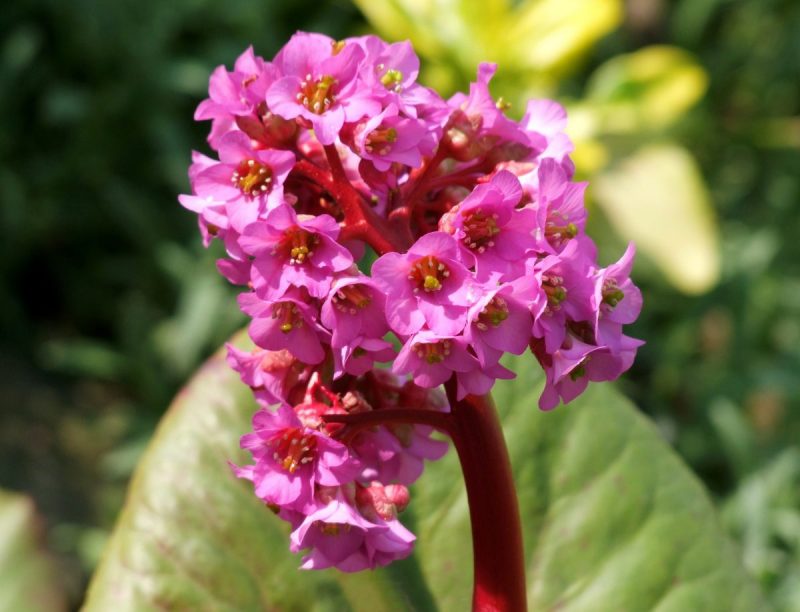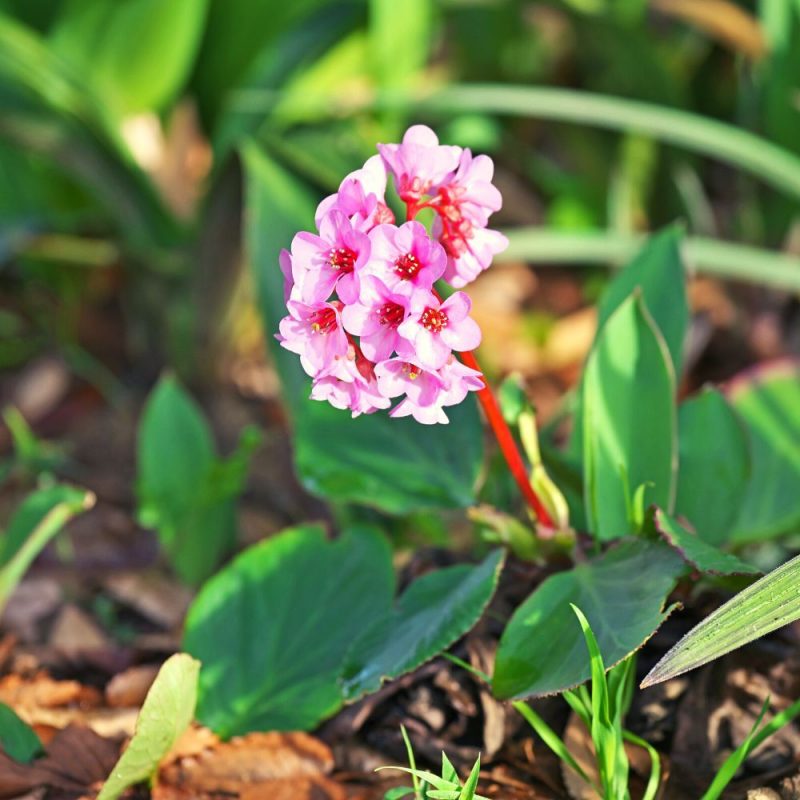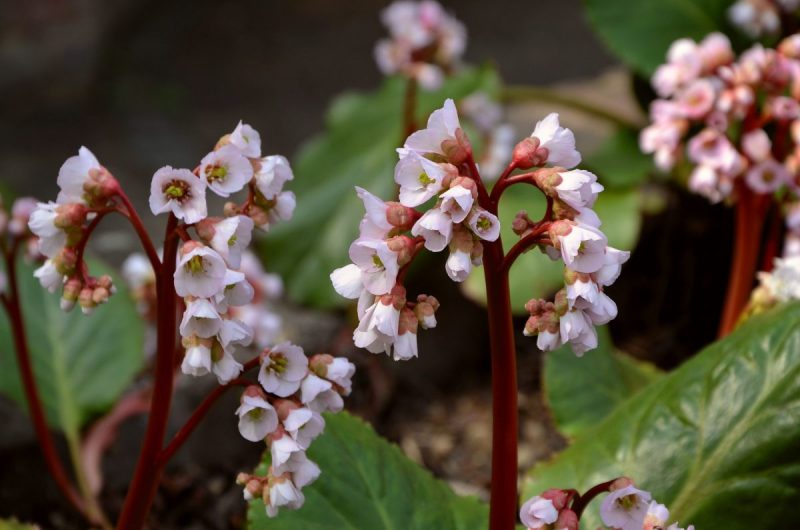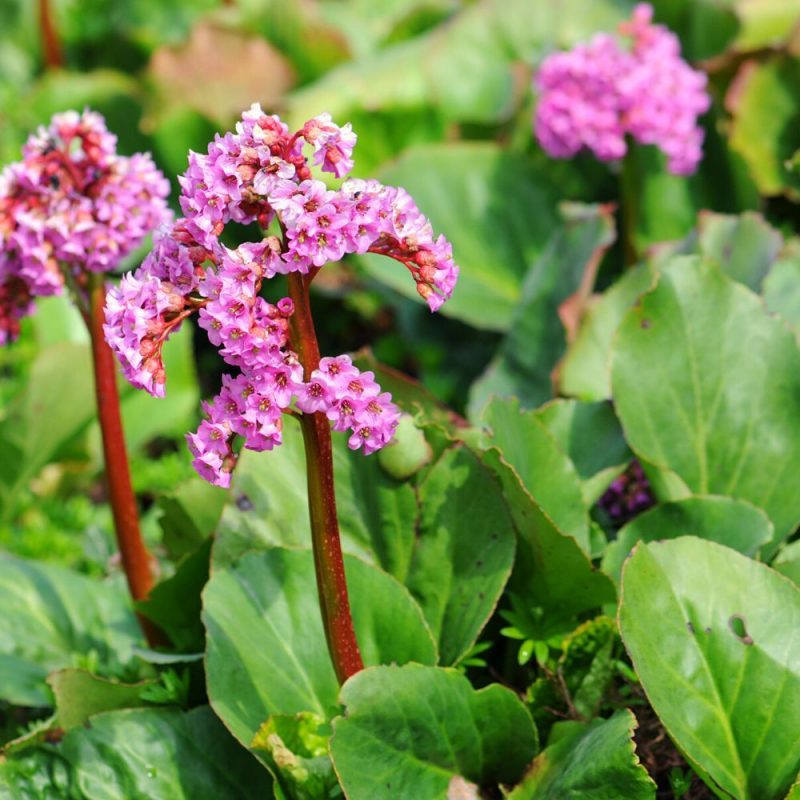Heartleaf Bergenia, planting guide and care work

Heartleaf Bergenia (Bergenia cordifolia) is a perennial, rhizomatous plant, originating in Asia. The Heartleaf Bergenia is decorative thanks to its flowers and leaves, being cultivated in gardens, as a plant for covering the ground, next to curbs, in rockeries, etc., and also in flowerpots. The leaves are large, cordiform, often with wavy edges, dark green in the summer, and bronze in the autumn. The flowers form at the top of the rigid rhubarb-colored stems. The flowers can be pink, red, white and occur in early spring.
Heartleaf Bergenia – varieties and cultivars
- B. cordifolia ‘Winter Glow’: it has red stems and pink flowers. It can grow to a height of up to 60 cm;
- B. cordifolia ‘Bressingham White’: with bouquets of white flowers that contrast with the intense green leaves. It can reach a height of up to 38 cm;
- B. cordifolia ‘Angel Kiss’: it is a shorter plant, reaching a height of up 25 cm high. Its flowers are white or light pink;
- B. cordifolia ‘Ballawley’: with pink flowers and red stems;
- B. cordifolia ‘Solar Flare’: it is distinguished by its variegated, green leaves with yellow edges. It has a medium size and magenta flowers.



Environmental conditions
Light. It grows well in partial shade, but it can also tolerate shaded areas. If it is grown in sunny areas, it is important to ensure an adequate humidity.
Temperature. Heartleaf Bergenia can withstand the cold season and temperatures of -18 ℃.
Soil. It prefers rich, light soils that ensure a good water drainage. The soil can have a neutral or slightly alkaline pH. However, Bergenia can also grow on poorer or clayey soils.
Heartleaf Bergenia – care
Watering. The plants are watered regularly, so that the soil is permanently damp. If they are grown in shaded areas, the plants can tolerate drought conditions, but for a short period of time.
Propagation. It can be propagated by dividing the bush (in autumn) or by seeds.
Fertilizing. It reacts favorably to the application of fertilizers. Fertilizers specially formulated for flowering plants can be administered.
Recommended products
-
You can find products on a different store
Change Store -
You can find products on a different store
Change Store -
You can find products on a different store
Change Store -
You can find products on a different store
Change Store -
You can find products on a different store
Change Store -
You can find products on a different store
Change Store -
You can find products on a different store
Change Store -
You can find products on a different store
Change Store -
You can find products on a different store
Change Store -
You can find products on a different store
Change Store -
You can find products on a different store
Change Store -
You can find products on a different store
Change Store -
You can find products on a different store
Change Store -
You can find products on a different store
Change Store -
You can find products on a different store
Change Store -
You can find products on a different store
Change Store -
You can find products on a different store
Change Store -
You can find products on a different store
Change Store -
You can find products on a different store
Change Store -
You can find products on a different store
Change Store -
You can find products on a different store
Change Store -
You can find products on a different store
Change Store -
You can find products on a different store
Change Store -
You can find products on a different store
Change Store
Diseases and pests
Heartleaf Bergenia is relatively resistant to diseases, but it can sometimes be affected by leaf spots or Anthracnose. Among the pests, snails or weevils can infest the plant, as well as other defoliating insects.
Recommended products
-
You can find products on a different store
Change Store -
You can find products on a different store
Change Store -
You can find products on a different store
Change Store -
You can find products on a different store
Change Store -
You can find products on a different store
Change Store -
You can find products on a different store
Change Store -
You can find products on a different store
Change Store -
You can find products on a different store
Change Store -
You can find products on a different store
Change Store -
You can find products on a different store
Change Store -
You can find products on a different store
Change Store -
You can find products on a different store
Change Store -
You can find products on a different store
Change Store -
You can find products on a different store
Change Store -
You can find products on a different store
Change Store -
You can find products on a different store
Change Store -
You can find products on a different store
Change Store -
You can find products on a different store
Change Store -
You can find products on a different store
Change Store -
You can find products on a different store
Change Store -
You can find products on a different store
Change Store -
You can find products on a different store
Change Store -
You can find products on a different store
Change Store -
You can find products on a different store
Change Store
Recommended products
-
You can find products on a different store
Change Store -
You can find products on a different store
Change Store -
You can find products on a different store
Change Store -
You can find products on a different store
Change Store -
You can find products on a different store
Change Store -
You can find products on a different store
Change Store -
You can find products on a different store
Change Store -
You can find products on a different store
Change Store -
You can find products on a different store
Change Store -
You can find products on a different store
Change Store -
You can find products on a different store
Change Store -
You can find products on a different store
Change Store -
You can find products on a different store
Change Store -
You can find products on a different store
Change Store -
You can find products on a different store
Change Store -
You can find products on a different store
Change Store -
You can find products on a different store
Change Store -
You can find products on a different store
Change Store -
You can find products on a different store
Change Store -
You can find products on a different store
Change Store -
You can find products on a different store
Change Store -
You can find products on a different store
Change Store -
You can find products on a different store
Change Store -
You can find products on a different store
Change Store
Additionally:
- To maintain the pleasant appearance of the plants, it is recommended to remove the dried flowers;
- In regions with harsh winters, Heartleaf Bergenia can completely lose its leaves, but they will form again in spring.















































































































































































































































































































































































































































